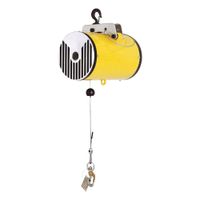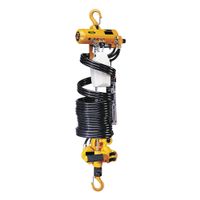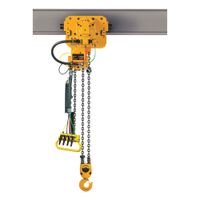Call +(254) 703 030 000 / 751 483 999 / 721 704 777
- Home
- Material Handling
- Lifting Pulling Positioning
- Hoists Trolleys
- Air Hoists Balancers
.....Read More
Frequently Asked Questions
What are the benefits of using air hoists and balancers over electric hoists?
Air hoists and balancers offer several advantages over electric hoists, particularly in specific industrial applications:
1. **Safety in Hazardous Environments**: Air hoists are ideal for environments with flammable gases or dust, as they do not produce sparks, unlike electric hoists. This makes them safer for use in industries like petrochemicals and mining.
2. **Continuous Operation**: Air hoists can operate continuously without overheating, which is a limitation for many electric hoists. This makes them suitable for applications requiring prolonged or repetitive lifting.
3. **Variable Speed Control**: Air hoists provide precise control over lifting speeds, allowing for smooth and accurate positioning of loads. This is particularly beneficial in assembly lines or when handling delicate materials.
4. **Durability and Low Maintenance**: Air hoists generally have fewer moving parts and are less susceptible to wear and tear compared to electric hoists. This results in lower maintenance costs and longer service life.
5. **Lightweight and Portable**: Air hoists are often lighter and more compact than their electric counterparts, making them easier to transport and install in various locations.
6. **Load Balancing**: Air balancers offer the ability to balance loads effortlessly, providing a "float" effect that allows operators to move heavy objects with minimal effort. This reduces operator fatigue and increases productivity.
7. **Resistance to Environmental Conditions**: Air hoists are less affected by environmental factors such as moisture, dust, and temperature extremes, making them suitable for outdoor or harsh conditions.
8. **Cost-Effectiveness in Certain Applications**: In facilities with existing compressed air systems, air hoists can be more cost-effective due to lower energy consumption and reduced infrastructure requirements compared to electric hoists.
These benefits make air hoists and balancers a preferred choice in many industrial settings where safety, precision, and durability are paramount.
How do air hoists and balancers prevent overheating during operation?
Air hoists and balancers prevent overheating through several mechanisms:
1. **Pneumatic Operation**: Air hoists and balancers use compressed air as their primary power source, which inherently dissipates heat more effectively than electric motors. The continuous flow of air helps in cooling the system components.
2. **Heat Dissipation**: The design of air hoists includes components that facilitate heat dissipation. The metal parts and open design allow heat to escape easily, preventing accumulation.
3. **Intermittent Duty Cycle**: These devices are often used in applications that do not require continuous operation, allowing time for cooling between cycles. This intermittent use reduces the risk of overheating.
4. **Built-in Cooling Systems**: Some air hoists and balancers are equipped with built-in cooling systems or fins that increase the surface area for heat dissipation, further preventing overheating.
5. **Lubrication**: Proper lubrication of moving parts reduces friction, which in turn minimizes heat generation. Many air hoists have automatic lubrication systems to ensure consistent performance.
6. **Overload Protection**: Air hoists and balancers often include overload protection mechanisms that prevent the system from operating beyond its capacity, which could lead to excessive heat generation.
7. **Material Selection**: The materials used in the construction of air hoists are chosen for their thermal properties, ensuring they can withstand and dissipate heat effectively.
8. **Regular Maintenance**: Routine maintenance checks ensure that all components are functioning correctly and that there is no excessive wear that could lead to increased friction and heat.
These features collectively ensure that air hoists and balancers operate efficiently without overheating, even under demanding conditions.
In what environments are air hoists and balancers most suitable for use?
Air hoists and balancers are most suitable for environments where safety, precision, and efficiency are paramount. These environments typically include:
1. **Hazardous Areas**: Air hoists are ideal in environments with flammable gases, vapors, or dust, as they do not produce sparks, unlike electric hoists. This makes them suitable for chemical plants, oil refineries, and mining operations.
2. **Heavy Industrial Settings**: In industries such as automotive, aerospace, and manufacturing, air hoists and balancers are used for lifting heavy components with precision. Their ability to handle high-duty cycles and provide smooth, controlled movements is crucial in these settings.
3. **Clean Rooms**: Air hoists are preferred in clean room environments, such as those in pharmaceutical or electronics manufacturing, because they do not emit contaminants that could compromise the sterile conditions.
4. **Marine and Offshore**: The robust construction and corrosion-resistant materials of air hoists make them suitable for marine and offshore applications, where they are used for lifting equipment and materials in harsh, salty environments.
5. **Construction Sites**: Air hoists are used in construction for lifting heavy materials and equipment. Their durability and ability to operate in various weather conditions make them ideal for outdoor use.
6. **Assembly Lines**: In assembly line operations, air balancers provide ergonomic assistance by allowing workers to maneuver heavy parts with minimal effort, reducing fatigue and the risk of injury.
7. **Food and Beverage Industry**: Air hoists are used in food processing plants where hygiene is critical, as they do not require lubricants that could contaminate products.
Overall, air hoists and balancers are chosen for environments where reliability, safety, and precision are essential, and where electric or hydraulic systems may pose risks or be less effective.
What safety precautions should be taken when operating air hoists and balancers?
1. **Training and Certification**: Ensure operators are properly trained and certified to use air hoists and balancers. Regularly update training to include new safety protocols.
2. **Pre-Operation Inspection**: Conduct a thorough inspection of the equipment before use. Check for wear and tear, proper lubrication, and any visible damage to components like hooks, chains, and cables.
3. **Load Limits**: Adhere strictly to the manufacturer's specified load limits. Never exceed the rated capacity of the hoist or balancer.
4. **Work Area Safety**: Keep the work area clear of obstructions and ensure it is well-lit. Mark the operating area to prevent unauthorized personnel from entering.
5. **Personal Protective Equipment (PPE)**: Operators should wear appropriate PPE, including gloves, hard hats, and safety glasses, to protect against potential hazards.
6. **Proper Rigging**: Use appropriate slings, hooks, and attachments. Ensure they are correctly secured and capable of handling the load.
7. **Control and Operation**: Use controls smoothly to avoid sudden movements. Be familiar with emergency stop procedures and ensure controls are easily accessible.
8. **Load Stability**: Ensure the load is balanced and stable before lifting. Avoid lifting loads over people and always maintain a safe distance.
9. **Regular Maintenance**: Follow a regular maintenance schedule as per the manufacturer's guidelines. Replace worn-out parts immediately.
10. **Emergency Procedures**: Have clear emergency procedures in place. Ensure all operators know how to respond to equipment failure or accidents.
11. **Environmental Conditions**: Be aware of environmental factors such as wind, rain, or extreme temperatures that may affect operation.
12. **Communication**: Maintain clear communication with team members during operation. Use hand signals or radios if necessary.
13. **Documentation**: Keep detailed records of inspections, maintenance, and training to ensure compliance with safety standards.
How do hand controls on air hoists and balancers work?
Hand controls on air hoists and balancers operate by regulating the flow of compressed air to control the lifting and lowering of loads. These controls typically consist of a pendant or lever system that the operator manipulates to adjust the air pressure within the hoist or balancer.
When the operator activates the hand control, it opens or closes valves that modulate the air pressure. Increasing the air pressure causes the hoist to lift the load, while decreasing the pressure allows the load to lower. The hand control can be designed for variable speed operation, allowing the operator to precisely control the speed of lifting or lowering by adjusting the valve opening.
In some systems, the hand control may include additional features such as a load limiter or emergency stop. A load limiter prevents the hoist from lifting loads beyond its capacity by cutting off the air supply if the load exceeds a preset limit. An emergency stop button immediately halts the operation by venting the air pressure, ensuring safety in case of an emergency.
The hand controls are ergonomically designed for ease of use, often featuring a lightweight and durable construction to withstand industrial environments. They may also include visual indicators or tactile feedback to inform the operator of the hoist's status or load condition.
Overall, hand controls on air hoists and balancers provide a user-friendly interface for precise and safe load handling, leveraging the power of compressed air to facilitate efficient material movement in various industrial applications.
What is the difference between air chain hoists and air cable balancers?
Air chain hoists and air cable balancers are both pneumatic lifting devices, but they serve different purposes and have distinct operational characteristics.
Air Chain Hoists:
1. **Functionality**: Designed for heavy lifting, air chain hoists use a chain to lift and lower loads. They are ideal for vertical lifting tasks.
2. **Capacity**: Typically have higher load capacities, often ranging from a few hundred kilograms to several tons.
3. **Precision**: Offer precise control over lifting and lowering speeds, making them suitable for applications requiring exact positioning.
4. **Durability**: Built for rugged use, they are often used in industrial settings like manufacturing and construction.
5. **Operation**: Operated via a pendant control or remote, allowing the operator to control the lift from a safe distance.
6. **Speed**: Generally slower than balancers, focusing on power and precision rather than speed.
Air Cable Balancers:
1. **Functionality**: Designed for ergonomic handling, air cable balancers use a cable to balance and position lighter loads, allowing for easy manual movement.
2. **Capacity**: Typically handle lighter loads, usually up to a few hundred kilograms.
3. **Precision**: Provide smooth, continuous movement, allowing operators to position loads with minimal effort.
4. **Durability**: While robust, they are more suited for repetitive tasks in assembly lines or workstations.
5. **Operation**: Often feature a "float" mode, enabling the operator to manually guide the load with minimal resistance.
6. **Speed**: Allow for quick and easy movement, enhancing productivity in tasks requiring frequent load repositioning.
In summary, air chain hoists are used for heavy-duty lifting with precision, while air cable balancers are designed for ergonomic handling of lighter loads with ease and speed.
How do trolley-mounted air chain hoists function on I-beams and cranes?
Trolley-mounted air chain hoists function by utilizing compressed air to lift and move heavy loads along I-beams and cranes. These hoists are equipped with a motor powered by compressed air, which drives a chain mechanism to lift loads. The trolley, which is mounted on the I-beam or crane, allows the hoist to move horizontally along the beam.
The operation begins with the air motor receiving compressed air through a control valve, which is typically operated by a pendant control or a remote control system. The air motor converts the energy from the compressed air into mechanical energy, which drives the hoist's chain sprocket. This action causes the load chain to move, lifting or lowering the attached load.
The trolley itself is designed to fit the flange of the I-beam or crane, allowing it to roll smoothly along the beam. It typically consists of wheels or rollers that are mounted on bearings, ensuring minimal friction and easy movement. The trolley can be either manual, requiring an operator to push or pull it along the beam, or motorized, using an additional air motor to drive the trolley wheels for powered travel.
Safety features are integral to the design, including load brakes that automatically engage to hold the load in place when lifting is stopped, and overload protection to prevent lifting beyond the hoist's capacity. The use of air power provides a spark-free operation, making these hoists suitable for hazardous environments where electrical sparks could pose a risk.
Overall, trolley-mounted air chain hoists offer a versatile and efficient solution for lifting and moving heavy loads in industrial settings, providing both vertical and horizontal mobility along I-beams and cranes.


